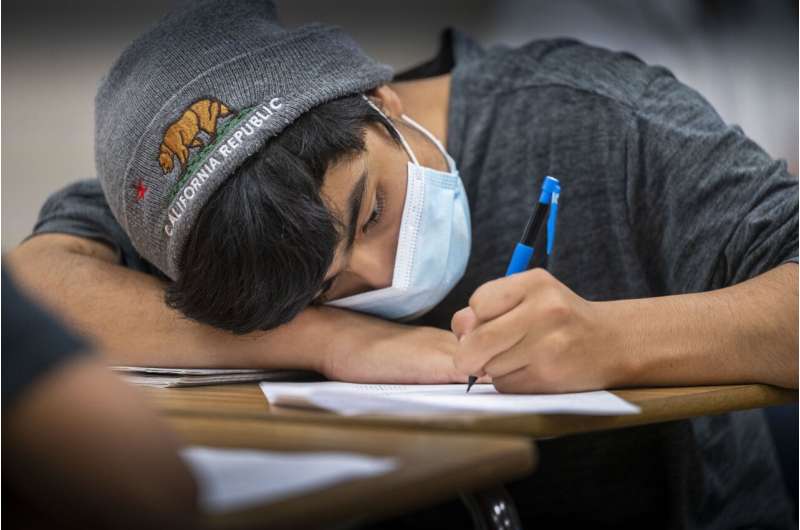Angel Cardenas, a freshman at Hiram Johnson High School, wears his mask while working on a math worksheet, Monday, June 6, 2022, the first day of the return to mandatory masking at all Sacramento City Unified School District locations, in Sacramento Despite a year of disruptions, students made largely academic gains in the past year that paralleled their pre-pandemic growth and were faster than the previous school year, according to new research released Tuesday, July 19, 2022 by NWEA, a nonprofit. research group that performs standardized tests. Credit: Hector Amezcua/The Sacramento Bee via AP, File
Despite a year of interruptions, students have made largely academic progress in the past year that paralleled their pre-pandemic growth and was faster than the previous school year, according to new researchers. Research released Tuesday by NWEA, a nonprofit research group that administers standardized tests.
Gains across income levels partially close the learning gap that resulted from the pandemic, researchers found. But students in high-income schools had fallen further behind, likely taking longer than their higher-income peers to fully recover.
The results are a measured sign of hope for academic recovery from COVID-19. But sustained efforts and investment in education remain crucial.
“These signs of recovery are especially encouraging during another challenging school year with more variants, staffing shortages and a host of uncertainties. We think this speaks volumes about our schools’ tremendous effort to support students,” Karyn Lewis, Director of the Center for School and Student Progress at NWEA, and the study’s co-author, in a statement.
The study used data from more than 8 million students who took the MAP Growth assessment for reading and math during the three school years affected by COVID. Those numbers were then compared with data from three years before the pandemic.
Kindergarten teacher Karen Drolet, left, works with a student at Raices Dual Language Academy, a public school in Central Falls, RI, Feb. 9, 2022. Despite a year of disruption, students have made largely academic gains in the past year that paralleled their growth pre pandemic and surpassed the previous school year, according to new research released Tuesday, July 19, 2022 by NWEA, a nonprofit research group that administers standardized testing. Credit: AP Photo/David Goldman, File
The study found that if the recovery is at the same pace as it was in the 2021-2022 school year, the timeline for a full recovery is likely to extend beyond the 2024 deadline for schools to spend their federal funds.
For the average elementary school student, researchers predicted it would take three years to get to where they would have been without the pandemic. For older students, recovery can take much longer. The exact timeline can vary widely between the different levels, subject and demographics, and researchers found that most students need more than the two years when more federal funding is available.
Some of the most successful interventions for students have been increasing learning time, ranging from more class time, intensive tutoring or high-quality summer programming, said Lindsay Dworkin, senior vice president for policy and communications at NWEA. But those initiatives can be costly and complex, and districts may be hesitant to implement them when recovery funds have a fast-approaching deadline to spend.
“The funding is running out in such a short time that districts are really struggling with, ‘What can I do that will be big and impactful and I only have to do that for two years?’” Dworkin said in an interview. “I think if they knew more federal money was coming and it was going to be sustained, that would make all the difference, both in the kind of creativity we’d see from states and districts.”
Dworkin also said that while the study looked at national trends, understanding the unique and specific local context was essential to figuring out how best to support children in schools. In addition to variation between student groups, districts with similar characteristics, such as demographics and poverty levels, still showed wide variation in student outcomes.
“If you’re a district leader, there’s just no national story that will tell you enough about your district context without the hard work of digging into the data and understanding what it’s saying and then tailoring interventions accordingly,” Dworkin said. . .
Distance learning likely widened the racial, economic performance gap
© 2022 The Associated Press. All rights reserved. This material may not be published, broadcast, rewritten or redistributed without permission.
Quote: Student gains last year narrowed COVID learning gap (2022, July 19) retrieved July 19, 2022 from https://phys.org/news/2022-07-student-gains-year-narrowed-covid.html
This document is copyrighted. Other than fair dealing for personal study or research, nothing may be reproduced without written permission. The content is provided for informational purposes only.

